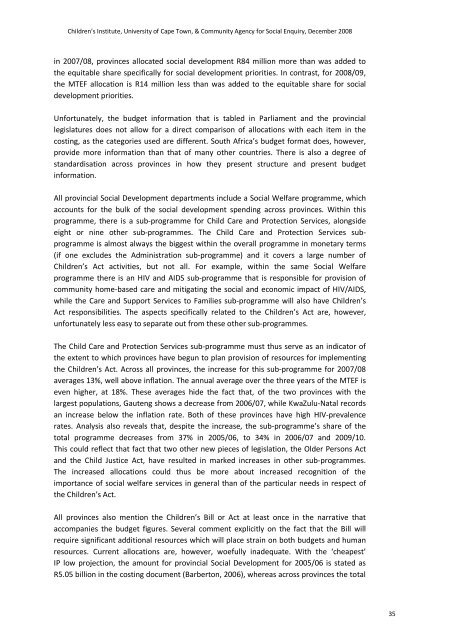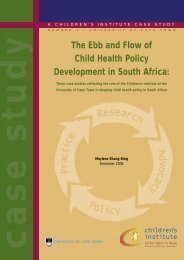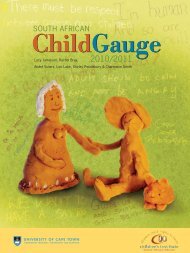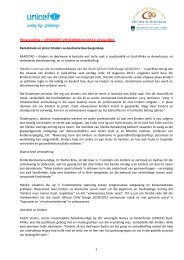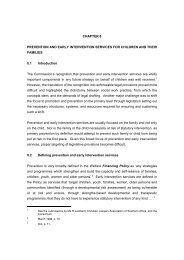Developing social policy for children in the context of HIV/AIDS:
Developing social policy for children in the context of HIV/AIDS:
Developing social policy for children in the context of HIV/AIDS:
You also want an ePaper? Increase the reach of your titles
YUMPU automatically turns print PDFs into web optimized ePapers that Google loves.
Children’s Institute, University <strong>of</strong> Cape Town, & Community Agency <strong>for</strong> Social Enquiry, December 2008<br />
<strong>in</strong> 2007/08, prov<strong>in</strong>ces allocated <strong>social</strong> development R84 million more than was added to<br />
<strong>the</strong> equitable share specifically <strong>for</strong> <strong>social</strong> development priorities. In contrast, <strong>for</strong> 2008/09,<br />
<strong>the</strong> MTEF allocation is R14 million less than was added to <strong>the</strong> equitable share <strong>for</strong> <strong>social</strong><br />
development priorities.<br />
Un<strong>for</strong>tunately, <strong>the</strong> budget <strong>in</strong><strong>for</strong>mation that is tabled <strong>in</strong> Parliament and <strong>the</strong> prov<strong>in</strong>cial<br />
legislatures does not allow <strong>for</strong> a direct comparison <strong>of</strong> allocations with each item <strong>in</strong> <strong>the</strong><br />
cost<strong>in</strong>g, as <strong>the</strong> categories used are different. South Africa’s budget <strong>for</strong>mat does, however,<br />
provide more <strong>in</strong><strong>for</strong>mation than that <strong>of</strong> many o<strong>the</strong>r countries. There is also a degree <strong>of</strong><br />
standardisation across prov<strong>in</strong>ces <strong>in</strong> how <strong>the</strong>y present structure and present budget<br />
<strong>in</strong><strong>for</strong>mation.<br />
All prov<strong>in</strong>cial Social Development departments <strong>in</strong>clude a Social Welfare programme, which<br />
accounts <strong>for</strong> <strong>the</strong> bulk <strong>of</strong> <strong>the</strong> <strong>social</strong> development spend<strong>in</strong>g across prov<strong>in</strong>ces. With<strong>in</strong> this<br />
programme, <strong>the</strong>re is a sub‐programme <strong>for</strong> Child Care and Protection Services, alongside<br />
eight or n<strong>in</strong>e o<strong>the</strong>r sub‐programmes. The Child Care and Protection Services subprogramme<br />
is almost always <strong>the</strong> biggest with<strong>in</strong> <strong>the</strong> overall programme <strong>in</strong> monetary terms<br />
(if one excludes <strong>the</strong> Adm<strong>in</strong>istration sub‐programme) and it covers a large number <strong>of</strong><br />
Children’s Act activities, but not all. For example, with<strong>in</strong> <strong>the</strong> same Social Welfare<br />
programme <strong>the</strong>re is an <strong>HIV</strong> and <strong>AIDS</strong> sub‐programme that is responsible <strong>for</strong> provision <strong>of</strong><br />
community home‐based care and mitigat<strong>in</strong>g <strong>the</strong> <strong>social</strong> and economic impact <strong>of</strong> <strong>HIV</strong>/<strong>AIDS</strong>,<br />
while <strong>the</strong> Care and Support Services to Families sub‐programme will also have Children’s<br />
Act responsibilities. The aspects specifically related to <strong>the</strong> Children’s Act are, however,<br />
un<strong>for</strong>tunately less easy to separate out from <strong>the</strong>se o<strong>the</strong>r sub‐programmes.<br />
The Child Care and Protection Services sub‐programme must thus serve as an <strong>in</strong>dicator <strong>of</strong><br />
<strong>the</strong> extent to which prov<strong>in</strong>ces have begun to plan provision <strong>of</strong> resources <strong>for</strong> implement<strong>in</strong>g<br />
<strong>the</strong> Children’s Act. Across all prov<strong>in</strong>ces, <strong>the</strong> <strong>in</strong>crease <strong>for</strong> this sub‐programme <strong>for</strong> 2007/08<br />
averages 13%, well above <strong>in</strong>flation. The annual average over <strong>the</strong> three years <strong>of</strong> <strong>the</strong> MTEF is<br />
even higher, at 18%. These averages hide <strong>the</strong> fact that, <strong>of</strong> <strong>the</strong> two prov<strong>in</strong>ces with <strong>the</strong><br />
largest populations, Gauteng shows a decrease from 2006/07, while KwaZulu‐Natal records<br />
an <strong>in</strong>crease below <strong>the</strong> <strong>in</strong>flation rate. Both <strong>of</strong> <strong>the</strong>se prov<strong>in</strong>ces have high <strong>HIV</strong>‐prevalence<br />
rates. Analysis also reveals that, despite <strong>the</strong> <strong>in</strong>crease, <strong>the</strong> sub‐programme’s share <strong>of</strong> <strong>the</strong><br />
total programme decreases from 37% <strong>in</strong> 2005/06, to 34% <strong>in</strong> 2006/07 and 2009/10.<br />
This could reflect that fact that two o<strong>the</strong>r new pieces <strong>of</strong> legislation, <strong>the</strong> Older Persons Act<br />
and <strong>the</strong> Child Justice Act, have resulted <strong>in</strong> marked <strong>in</strong>creases <strong>in</strong> o<strong>the</strong>r sub‐programmes.<br />
The <strong>in</strong>creased allocations could thus be more about <strong>in</strong>creased recognition <strong>of</strong> <strong>the</strong><br />
importance <strong>of</strong> <strong>social</strong> welfare services <strong>in</strong> general than <strong>of</strong> <strong>the</strong> particular needs <strong>in</strong> respect <strong>of</strong><br />
<strong>the</strong> Children’s Act.<br />
All prov<strong>in</strong>ces also mention <strong>the</strong> Children’s Bill or Act at least once <strong>in</strong> <strong>the</strong> narrative that<br />
accompanies <strong>the</strong> budget figures. Several comment explicitly on <strong>the</strong> fact that <strong>the</strong> Bill will<br />
require significant additional resources which will place stra<strong>in</strong> on both budgets and human<br />
resources. Current allocations are, however, woefully <strong>in</strong>adequate. With <strong>the</strong> ‘cheapest’<br />
IP low projection, <strong>the</strong> amount <strong>for</strong> prov<strong>in</strong>cial Social Development <strong>for</strong> 2005/06 is stated as<br />
R5.05 billion <strong>in</strong> <strong>the</strong> cost<strong>in</strong>g document (Barberton, 2006), whereas across prov<strong>in</strong>ces <strong>the</strong> total<br />
35


